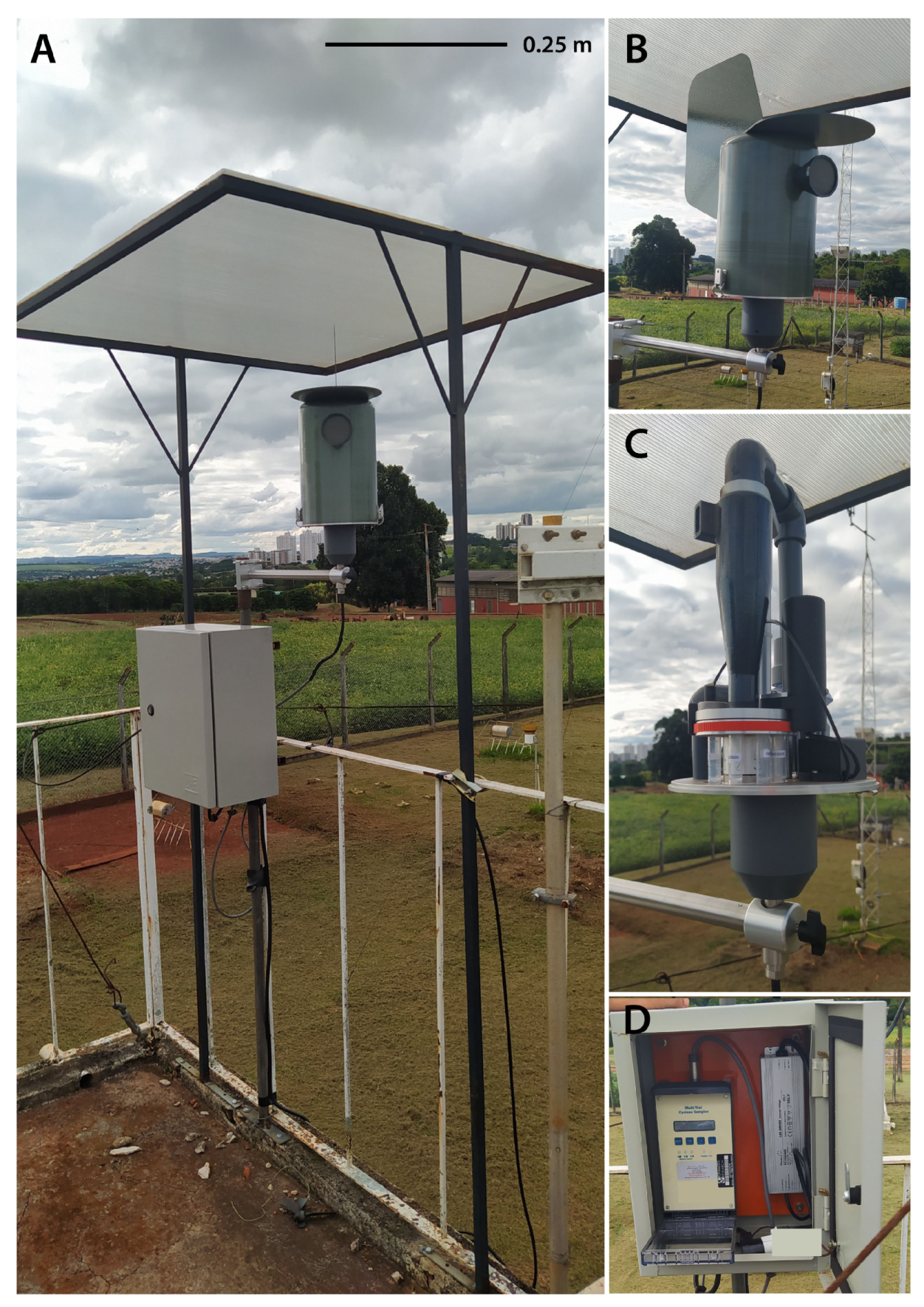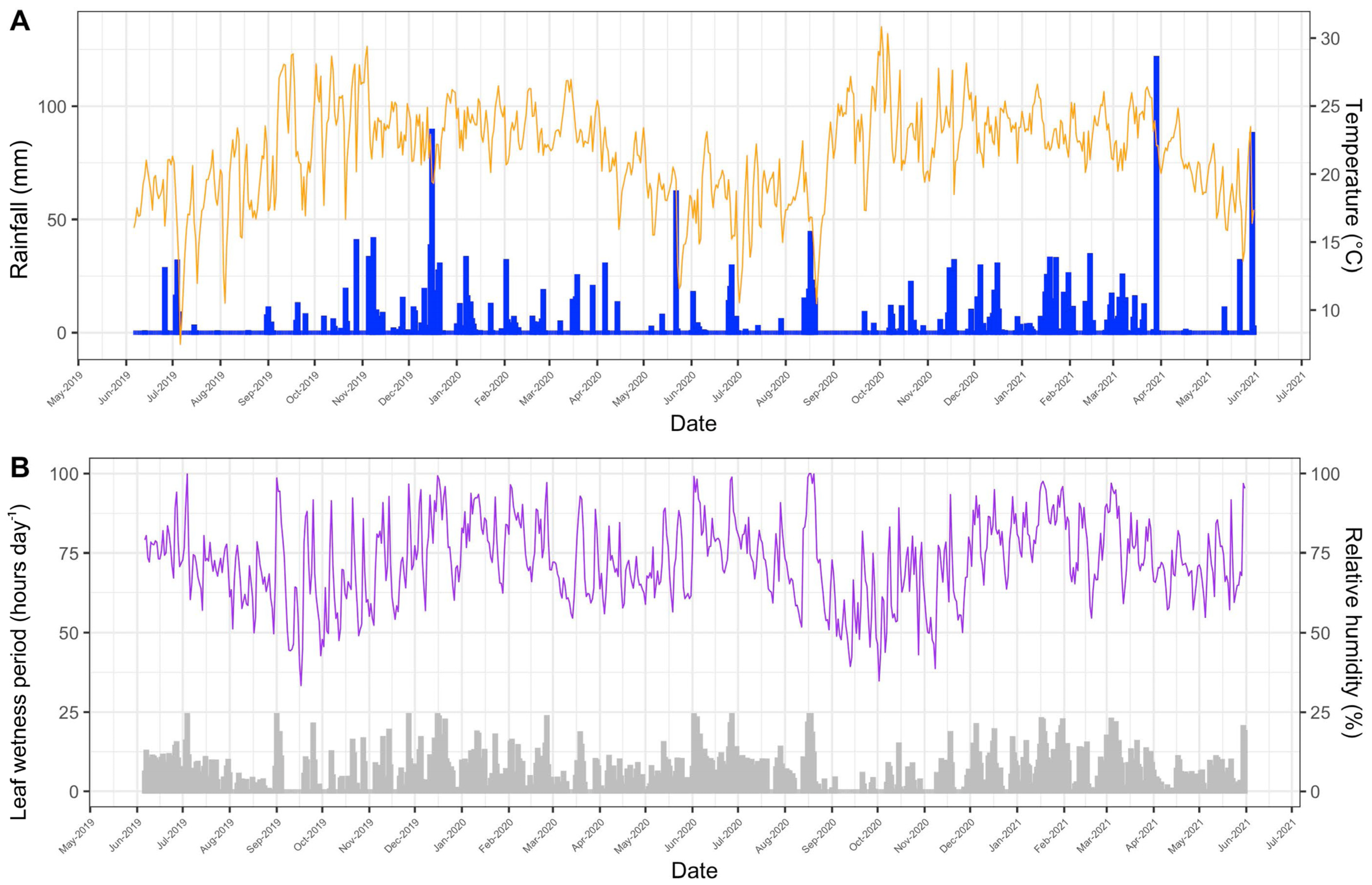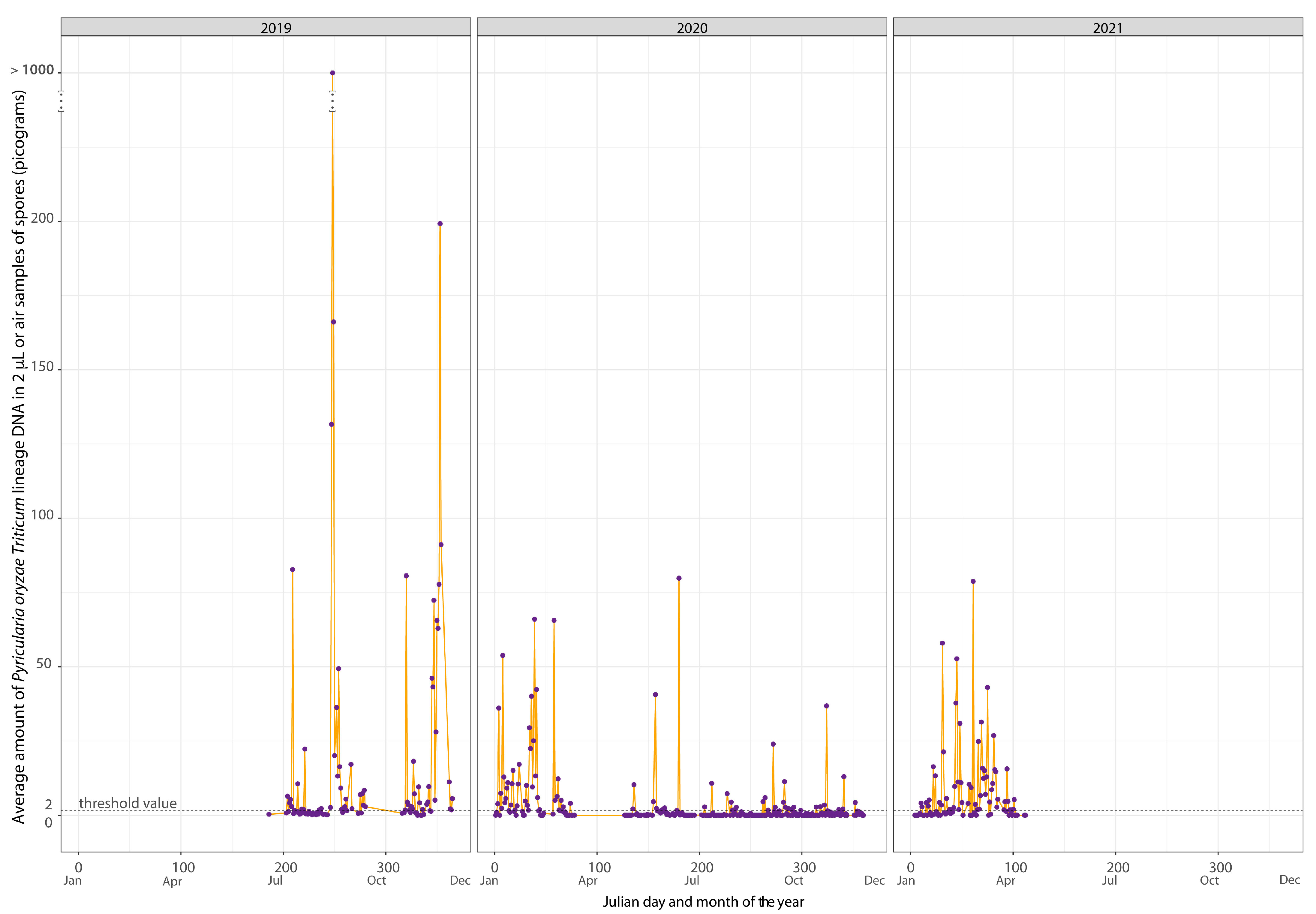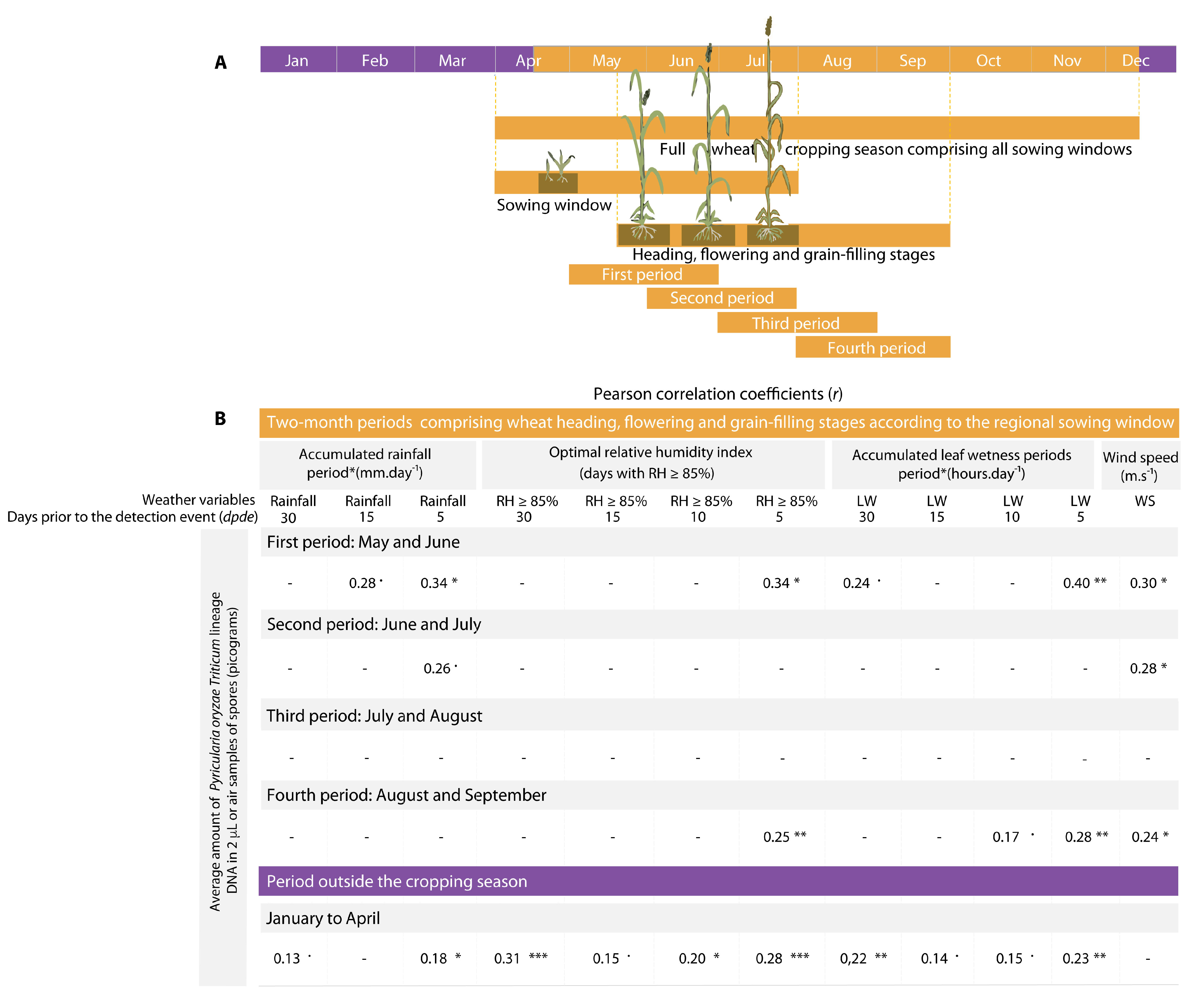Aerobiology of the Wheat Blast Pathogen: Inoculum Monitoring and Detection of Fungicide Resistance Alleles
Abstract
1. Introduction
2. Materials and Methods
2.1. Fungal DNA Extraction from Air Samples and Purification
2.2. Detection of PoTl in Air Samples Using qPCR
2.3. Pyrosequencing Assay for cytb Alleles Quantification in Airborne PoTl Populations
2.4. Pearson Correlation Analysis among Weather Variables and the Amount of PoTl DNA Detected in Air Samples Using a Real Time qPCR Assay
2.5. Descriptive Representation of the Time Series and Statistical Analyses
3. Results
3.1. Detection of PoTl in Aerosol Samples Using qPCR
3.2. Quantification of QoI-Resistant cytb Alleles in PoTl Populations Present in Air Samples
3.3. Pearson Correlation Analysis among Weather Variables and the Amount of PoTl DNA in Air Samples
4. Discussion
Author Contributions
Funding
Informed Consent Statement
Data Availability Statement
Acknowledgments
Conflicts of Interest
References
- Igarashi, S.; Utiamada, C.; Igarashi, L.; Kazuma, A.; Lopes, R. Pyricularia Em Trigo. 1. Ocorrência de Pyricularia sp. No Estado Do Paraná. Fitopatol. Bras. 1986, 11, 351–352. [Google Scholar]
- Ceresini, P.C.; Castroagudin, V.L.; Rodrigues, F.A.; Rios, J.A.; Eduardo Aucique-Perez, C.; Moreira, S.I.; Alves, E.; Croll, D.; Maciel, J.L.N. Wheat Blast: Past, Present, and Future. Annu. Rev. Phytopathol. 2018, 56, 427–456. [Google Scholar] [CrossRef]
- Cruz, C.D.; Santana, F.M.; Todd, T.C.; Maciel, J.L.N.; Kiyuna, J.; Baldelomar, D.F.; Cruz, A.P.; Lau, D.; Seixas, C.S.; Goulart, A.C.P.; et al. Multi-Environment Assessment of Fungicide Performance for Managing Wheat Head Blast (WHB) in Brazil and Bolivia. Trop. Plant Pathol. 2019, 44, 183–191. [Google Scholar] [CrossRef]
- Kohli, M.; Mehta, Y.R.; Guzman, E.; Viedma, L.; Cubilla, L.E. Pyricularia Blast–a Threat to Wheat Cultivation. Czech J. Genet. Plant Breed. 2011, 47, S130–S134. [Google Scholar] [CrossRef]
- Islam, M.T.; Croll, D.; Gladieux, P.; Soanes, D.M.; Persoons, A.; Bhattacharjee, P.; Hossain, M.S.; Gupta, D.R.; Rahman, M.M.; Mahboob, M.G.; et al. Emergence of Wheat Blast in Bangladesh Was Caused by a South American Lineage of Magnaporthe Oryzae. BMC Biol. 2016, 14, 84. [Google Scholar] [CrossRef] [PubMed]
- Tembo, B.; Mulenga, R.M.; Sichilima, S.; M’Siska, K.K.; Mwale, M.; Chikoti, P.C.; Singh, P.K.; He, X.; Pedley, K.F.; Peterson, G.L.; et al. Detection and Characterization of Fungus (Magnaporthe Oryzae Pathotype Triticum) Causing Wheat Blast Disease on Rain-Fed Grown Wheat (Triticum Aestivum L.) in Zambia. PLoS ONE 2020, 15, e0238724. [Google Scholar] [CrossRef]
- Malaker, P.K.; Barma, N.C.D.; Tiwari, T.P.; Collis, W.J.; Duveiller, E.; Singh, P.K.; Joshi, A.K.; Singh, R.P.; Braun, H.J.; Peterson, G.L.; et al. First Report of Wheat Blast Caused By Magnaporthe Oryzae Pathotype Triticum in Bangladesh. Plant Dis. 2016, 100, 2330. [Google Scholar] [CrossRef]
- McDonald, B.A.; Stukenbrock, E.H. Rapid Emergence of Pathogens in Agro-Ecosystems: Global Threats to Agricultural Sustainability and Food Security. Philos. Trans. R. Soc. Lond. B Biol. Sci. 2016, 371. [Google Scholar] [CrossRef] [PubMed]
- Sadat, M.A.; Choi, J. Wheat Blast: A New Fungal Inhabitant to Bangladesh Threatening World Wheat Production. Plant Pathol. J. 2017, 33, 103–108. [Google Scholar] [CrossRef]
- Maciel, J.L.N.; Ceresini, P.C.; Castroagudin, V.L.; Zala, M.; Kema, G.H.J.; McDonald, B.A. Population Structure and Pathotype Diversity of The Wheat Blast Pathogen Magnaporthe Oryzae 25 Years After Its Emergence in Brazil. Phytopathology 2014, 104, 95–107. [Google Scholar] [CrossRef] [PubMed]
- Pizolotto, C.A.; Maciel, J.L.N.; Fernandes, J.M.C.; Boller, W. Saprotrophic Survival of Magnaporthe Oryzae in Infested Wheat Residues. Eur. J. Plant Pathol. 2019, 153, 327–339. [Google Scholar] [CrossRef]
- Castroagudín, V.L.; Danelli, A.L.D.; Moreira, S.I.; Reges, J.T.A.; de Carvalho, G.; Maciel, J.L.N.; Bonato, A.L.V.; Forcelini, C.A.; Alves, E.; McDonald, B.A.; et al. The Wheat Blast Pathogen Pyricularia Graminis-Tritici Has Complex Origins and a Disease Cycle Spanning Multiple Grass Hosts. bioRxiv 2017, 203455. [Google Scholar] [CrossRef]
- Urashima, A.S.; Leite, S.F.; Galbieri, R. Eficiência Da Disseminação Aérea Em Pyricularia Grisea. Summa Phytopathol. 2007, 33, 275–279. [Google Scholar] [CrossRef]
- Gomes, D.P.; Rocha, V.S.; Pereira, O.L.; de Souza, M.A. Damage of Wheat Blast on the Productivity and Quality of Seeds as a Function of the Initial Inoculum in the Field. J. Seed Sci. 2017, 39, 066–074. [Google Scholar] [CrossRef]
- Goulart, A.C.P.; Paiva, F.A.; Andrade, P.J.M. Relação Entre A Incidência Da Brusone Em Espigas De Trigo E A Presença De Pyricularia Grisea Nas Sementes Colhidas. Fitopatol. Bras. 1995, 20, 184–189. [Google Scholar]
- Goulart, A.C.P.; Paiva, F.d.A. Sobrevivência De Pyricularia oryzae Cav. Em Sementes De Trigo (Triticum aestivum L.) Armazenadas Em Diferentes Ambientes. Rev. Bras. Sementes 1993, 15, 153–156. [Google Scholar] [CrossRef]
- Urashima, A.S.; Lavorent, N.A.; Goulart, A.C.P.; Mehta, Y.R. Resistance Spectra of Wheat Cultivars and Virulence Diversity of Magnaporthe Grisea Isolates in Brazil. Fitopatol. Bras. 2004, 29, 511–518. [Google Scholar] [CrossRef]
- Cruz, M.F.; Prestes, A.M.; Maciel, J.L.N.; Scheeren, P.L. Resistência Parcial À Brusone De Genótipos De Trigo Comum E Sintético Nos Estádios De Planta Jovem E De Planta Adulta. Trop. Plant Pathol. 2010, 35, 24–31. [Google Scholar] [CrossRef]
- Torres, G.A.M.; Ferreira, J.R.; Binneck, E.; Maciel, J.L.N.; Consoli, L. Blast Disease and Wheat Production in Brazil. Pesqui. Agropecuária Bras. 2022, 57, 02487. [Google Scholar] [CrossRef]
- Sharma, R. Wheat Blast Research: Status and Imperatives. Afr. J. Agric. Res. 2017, 12, 377–381. [Google Scholar] [CrossRef]
- Poloni, N.M.; Carvalho, G.; Nunes Campos Vicentini, S.; Francis Dorigan, A.; Nunes Maciel, J.L.; McDonald, B.A.; Intra Moreira, S.; Hawkins, N.; Fraaije, B.A.; Kelly, D.E.; et al. Widespread Distribution of Resistance to Triazole Fungicides in Brazilian Populations of The Wheat Blast Pathogen. Plant Pathol. 2021, 70, 436–448. [Google Scholar] [CrossRef]
- Castroagudín, V.L.; Ceresini, P.C.; Oliveira, S.C.; Reges, J.T.; Maciel, J.L.; Bonato, A.L.; Dorigan, A.F.; McDonald, B.A. Resistance to Qoi Fungicides Is Widespread in Brazilian Populations of The Wheat Blast Pathogen Magnaporthe Oryzae. Phytopathology 2015, 105, 284–294. [Google Scholar] [CrossRef]
- Oliveira, S.C.; Castroagudín, V.L.; Maciel, J.L.N.; Pereira, D.A.S.; Ceresini, P.C. Resistência Cruzada Aos Fungicidas Iqo Azoxistrobina E Piraclostrobina No Patógeno Da Brusone Do Trigo Pyricularia Oryzae No Brasil. Summa Phytopathol. 2015, 41, 298–304. [Google Scholar] [CrossRef]
- Vicentini, S.N.C.; Casado, P.S.; de Carvalho, G.; Moreira, S.I.; Dorigan, A.F.; Silva, T.C.; Silva, A.G.; Custódio, A.A.P.; Gomes, A.C.S.; Nunes Maciel, J.L.; et al. Monitoring of Brazilian Wheat Blast Field Populations Reveals Resistance to Qoi, DMI, and SDHI Fungicides. Plant Pathol. 2022, 71, 304–321. [Google Scholar] [CrossRef]
- Pagani, A.P.S.; Dianese, A.C.; Café-Filho, A.C. Management of Wheat Blast With Synthetic Fungicides, Partial Resistance and Silicate and Phosphite Minerals. Phytoparasitica 2014, 42, 609–617. [Google Scholar] [CrossRef]
- Corkley, I.; Fraaije, B.; Hawkins, N. Fungicide Resistance Management: Maximizing The Effective Life of Plant Protection Products. Plant Pathol. 2022, 71, 150–169. [Google Scholar] [CrossRef]
- Van der Heyden, H.; Dutilleul, P.; Charron, J.-B.; Bilodeau, G.J.; Carisse, O. Monitoring Airborne Inoculum for Improved Plant Disease Management. A review. Agron. Sustain. Dev. 2021, 41, 40. [Google Scholar] [CrossRef]
- Cruz, C.; Kiyunab, J.; Bockusa, W.; Todda, T.; Stack, J.; Valent, B. Magnaporthe Oryzae Conidia on Basal Wheat Leaves as a Potential Source of Wheat Blast Inoculum. Plant Pathol. 2015, 64, 1491–1498. [Google Scholar] [CrossRef]
- Urashima, A.S.; Grosso, C.R.F.; Stabili, A.; Freitas, E.G.; Silva, C.P.; Netto, D.C.S.; Franco, I.; Bottan, J.H.M. Effect of Magnaporthe Grisea on Seed Germination, Yield and Quality of Wheat. In Advances in Genetics, Genomics and Control of Rice Blast Disease; Springer: Dordrecht, The Netherlands, 2009; pp. 267–277. [Google Scholar]
- Cardoso, C.A.d.A.; Reis, E.M.; Moreira, E.N. Development of a Warning System for Wheat Blast Caused by Pyricularia Grisea. Summa Phytopathol. 2008, 34, 216–221. [Google Scholar] [CrossRef]
- Fernandes, J.M.C.; Nicolau, M.; Pavan, W.; Hölbig, C.A.; Karrei, M.; de Vargas, F.; Bavaresco, J.L.B.; Lazzaretti, A.T.; Tsukahara, R.Y. A Weather-Based Model for Predicting Early Season Inoculum Build-Up and Spike Infection by the Wheat Blast Pathogen. Trop. Plant Pathol. 2017, 42, 230–237. [Google Scholar] [CrossRef]
- Fernandes, J.M.; Del Ponte, E.; Ascari, J.; Krupnik, T.; Pavan, W.; Vargas, F.; Berton, T. Towards an Early Warning System for Wheat Blast: Epidemiological Basis and Model Development; Burleigh Dodds: Cambridge, UK, 2021; pp. 623–641. [Google Scholar] [CrossRef]
- Cruz, C.D.; Magarey, R.D.; Christie, D.N.; Fowler, G.A.; Fernandes, J.M.; Bockus, W.W.; Valent, B.; Stack, J.P. Climate Suitability for Magnaporthe oryzae Triticum Pathotype in the United States. Plant Dis. 2016, 100, 1979–1987. [Google Scholar] [CrossRef] [PubMed]
- Nicolau, M.; Fernandes, J.M.; Danelli, A.L.D.; Pavan, W. Using a Bayesian Model for Estimating Airborne Infection Risks: Wheat blast. in International Symposium on Fusarium Head Blight, 5; International Workshop on Wheat Blast, 2. 2016, Florianópolis. Book of abstracts… Universidade de Passo Fundo, Embrapa Trigo: Passo Fundo, RS; Universidade Federal de Viçosa: Viçosa, MG. 2016, p. 159, abstr. P95. Available online: http://mosaico.upf.br/~events/scabandblastofwheat-book.pdf (accessed on 2 May 2022).
- West, J.S.; Canning, G.G.M.; Perryman, S.A.; King, K. Novel Technologies for The Detection of Fusarium Head Blight Disease and Airborne Inoculum. Trop. Plant Pathol. 2017, 42, 203–209. [Google Scholar] [CrossRef] [PubMed]
- West, J.S.; Kimber, R.B.E. Innovations in Air Sampling to Detect Plant Pathogens. Ann. Appl. Biol. 2015, 166, 4–17. [Google Scholar] [CrossRef]
- Hirst, J.M. An Automatic Volumetric Spore Trap. Ann. Appl. Biol. 1952, 39, 257–265. [Google Scholar] [CrossRef]
- Dedeurwaerder, G.; Duvivier, M.; Mvuyenkure, S.; Renard, M.; Hese, V.; Marchal, G.; Moreau, J.; Legrève, A. Spore Traps Network: A New Tool for Predicting Epidemics of Wheat Yellow Rust. Commun. Agric. Appl. Biol. Sci. 2011, 76, 667–670. [Google Scholar]
- Fraaije, B.A.; Cools, H.J.; Fountaine, J.; Lovell, D.J.; Motteram, J.; West, J.S.; Lucas, J.A. Role of Ascospores in Further Spread of QoI-Resistant Cytochrome b Alleles (G143A) in Field Populations of Mycosphaerella graminicola. Phytopathology 2005, 95, 933–941. [Google Scholar] [CrossRef] [PubMed]
- Duvivier, M.; Dedeurwaerder, G.; De Proft, M.; Moreau, J.-M.; Legrève, A. Real-Time PCR Quantification and Spatio-Temporal Distribution of Airborne Inoculum of Mycosphaerella Graminicola in Belgium. Eur. J. Plant Pathol. 2013, 137, 325–341. [Google Scholar] [CrossRef]
- Cao, X.; Yao, D.; Zhou, Y.; West, J.S.; Xu, X.; Luo, Y.; Ding, K.; Fan, J.; Duan, X. Detection and Quantification of Airborne Inoculum of Blumeria Graminis F. Sp. Tritici Using Quantitative PCR. Eur. J. Plant Pathol. 2016, 146, 225–229. [Google Scholar] [CrossRef]
- Carisse, O.; Levasseur, A.; Van der Heyden, H. A New Risk Indicator for Botrytis Leaf Blight of Onion Caused By Botrytis Squamosa Based on Infection Efficiency of Airborne Inoculum. Plant Pathol. 2012, 61, 1154–1164. [Google Scholar] [CrossRef]
- Pieck, M.; Ruck, A.; Farman, M.; Peterson, G.; Stack, J.; Valent, B.; Pedley, K. Genomics-Based Marker Discovery and Diagnostic Assay Development for Wheat Blast. Plant Dis. 2017, 101, 103–109. [Google Scholar] [CrossRef]
- Alves, K.J.P.; Fernandes, J.M.C. Influência Da Temperatura E Umidade Relativa Do Ar Na Esporulação De Magnaporthe Grisea Em Trigo. Fitopatol. Bras. 2006, 31, 579–584. [Google Scholar] [CrossRef]
- Ministério da Agricultura Pecuária e Abastecimento/Ministry of Agriculture Livestock and Suply—Brazil. National Program for Agricultural Zoning Based on Climate Risk [ZARC] for Paraná State. 2022. Available online: https://www.gov.br/agricultura/pt-br/assuntos/riscos-seguro/programa-nacional-de-zoneamento-agricola-de-risco-climatico/portarias/safra-vigente/parana/parana-pr (accessed on 2 May 2022).
- R Development Core Team. R: A Language and Environment for Statistical Computing. Vienna, Austria: The R Foundation for Statistical Computing. 2020. Available online: http://www.r-project.org/index.html (accessed on 2 May 2022).
- Luo, Y.; Ma, Z.; Reyes, H.; Morgan, D. Quantification of Airborne Spores of Monilinia Fructicola in Stone Fruit Orchards of California Using Real-Time PCR. Eur. J. Plant Pathol. 2007, 118, 145–154. [Google Scholar] [CrossRef]
- West, J.S.; Atkins, S.D.; Emberlin, J.; Fitt, B.D.L. PCR to Predict Risk of Airborne Disease. Trends Microbiol. 2008, 16, 380–387. [Google Scholar] [CrossRef]
- Danelli, A.; Fernandes, J.M.; Nunes Maciel, J.; Boaretto, C.; Forcelini, C. Monitoring Pyricularia sp. Airborne Inoculum in Passo Fundo, Rio Grande Do Sul, Brazil. Summa Phytopathol. 2019, 45, 361–367. [Google Scholar] [CrossRef]
- Maciel, J.L.N.; Kovaleski, M.; Silva, A.N.; Bonato, A.L.V.; Costa, I.F.D.d. Ocorrência De Pyricularia Oryzae Triticum Em Plantas Do Gênero Urochloa No Brasil. Ciência Rural. 2022, 53, e20210839. [Google Scholar] [CrossRef]
- Dorigan, A.F.; Moreira, S.I.; Ceresini, P.C.; Pozza, E.A.; Belan, L.L.; da Silveira, P.R.; Alves, E. Higher Fitness and Competitive Advantage of Pyricularia Oryzae Triticum Lineage Resistant to Qoi Fungicides. Pest Manag. Sci. 2022, 78, 5251–5258. [Google Scholar] [CrossRef]
- Hagerty, C.H.; Mundt, C.C. Reduced Virulence of Azoxystrobin-Resistant Zymoseptoria Tritici Populations in Greenhouse Assays. Phytopathology 2016, 106, 884–889. [Google Scholar] [CrossRef]
- Ma, B.; Uddin, W. Fitness and Competitive Ability of An Azoxystrobin-Resistant G143A Mutant of Magnaporthe Oryzae From Perennial Ryegrass. Plant Disease 2009, 93, 1044–1049. [Google Scholar] [CrossRef]
- Ishii, H.; Hollomon, D.W. Fungicide Resistance in Plant Pathogens, Principles and a Guide to Practical Management, 1st ed.; Hideo, I., Derek William, H., Eds.; Springer: Tokyo, Japan, 2015. [Google Scholar] [CrossRef]
- Vicentini, S.N.C.; Moreira, S.I.; Silva, A.G.d.; Oliveira, T.Y.K.; Silva, T.C.; Assis Junior, F.G.; Krug, L.D.; de Paiva Custódio, A.A.; Leite Júnior, R.P.; Teodoro, P.E.; et al. Efflux Pumps and Multidrug-Resistance in Pyricularia oryzae Triticum Lineage. Agronomy 2022, 12, 2068. [Google Scholar] [CrossRef]
- Cazón, L.I.; Ascari, J.P.; dos Santos, G.B.; Del Ponte, E.M. Differential Response to DMI, Qoi and SDHI Fungicides in Wheat and Signal Grass Blast Populations from Minas Gerais, Brazil. Plant Pathol. 2022, 72, 1–19. [Google Scholar] [CrossRef]
- Ascari, J.P.; Barro, J.P.; Santana, F.M.; Padua, J.M.V.; Maciel, J.L.N.; Lau, D.; Torres, G.A.M.; Sbalcheiro, C.C.; Seixas, C.D.S.; Goulart, A.C.P.; et al. Sequential Post-Heading Applications for Controlling Wheat Blast: A 9-Year Summary of Fungicide Performance in Brazil. Plant Dis. 2021, 105, 4051–4059. [Google Scholar] [CrossRef] [PubMed]
- Mair, W.; Lopez-Ruiz, F.; Stammler, G.; Clark, W.; Burnett, F.; Hollomon, D.; Ishii, H.; Thind, T.S.; Brown, J.K.; Fraaije, B.; et al. Proposal for a Unified Nomenclature for Target Site Mutations Associated With Resistance to Fungicides. Pest Manag. Sci. 2016, 8, 1449–1459. [Google Scholar] [CrossRef] [PubMed]
- Pieczul, K.; Wasowska, A. The Application of Next-Generation Sequencing (NGS) for Monitoring of Zymoseptoria Tritici Qoi Resistance. Crop Prot. 2017, 92, 143–147. [Google Scholar] [CrossRef]
- Gutierrez Vazquez, Y.; Adams, I.P.; McGreig, S.; Walshaw, J.; van den Berg, F.; Sanderson, R.; Hollie, P.; Conyers, C.; Langton, D.; Broadhead, R.; et al. Profiling Azole Resistant Haplotypes Within Zymoseptoria Tritici Populations Using Nanopore Sequencing. Front. Agron. 2022, 4, 943440. [Google Scholar] [CrossRef]





| Oligonucleotide Name | Type | Oligonucleotide Sequence and Labeling (5′–3′) |
|---|---|---|
| MoT3_1F | Forward primer for qPCR | AGGATGTATGCCCTGACTGG |
| MoT3_1R | Reverse primer for qPCR | CTCGGCGATGCAAAAGTGAA |
| MoT3_FAM2 | qPCR probe 1 | TTCTAACGGTTTGCAATTGCACAAAACAAC |
| cytb initial PCR | ||
| F1 | Forward primer | GTTTGAGCTATTGGTACTGTTATATTA |
| R1 | Reverse primer | GAAACACCAAGAGGATTGCTT |
| cytb nested PCR | ||
| F2 | Forward primer | GGCTATCGGTTTCCTAGGTTATGT |
| R2 | Reverse primer 2 | TGCCCTATTCAAGGTATAGCACTA |
| cytb primer for pyrosequencing | ||
| S1 | Sequencing primer | GGACAGATGTCATTATGAG |
Disclaimer/Publisher’s Note: The statements, opinions and data contained in all publications are solely those of the individual author(s) and contributor(s) and not of MDPI and/or the editor(s). MDPI and/or the editor(s) disclaim responsibility for any injury to people or property resulting from any ideas, methods, instructions or products referred to in the content. |
© 2023 by the authors. Licensee MDPI, Basel, Switzerland. This article is an open access article distributed under the terms and conditions of the Creative Commons Attribution (CC BY) license (https://creativecommons.org/licenses/by/4.0/).
Share and Cite
Vicentini, S.N.C.; Hawkins, N.J.; King, K.M.; Moreira, S.I.; de Paiva Custódio, A.A.; Leite Júnior, R.P.; Portalanza, D.; Garcés-Fiallos, F.R.; Krug, L.D.; West, J.S.; et al. Aerobiology of the Wheat Blast Pathogen: Inoculum Monitoring and Detection of Fungicide Resistance Alleles. Agronomy 2023, 13, 1238. https://doi.org/10.3390/agronomy13051238
Vicentini SNC, Hawkins NJ, King KM, Moreira SI, de Paiva Custódio AA, Leite Júnior RP, Portalanza D, Garcés-Fiallos FR, Krug LD, West JS, et al. Aerobiology of the Wheat Blast Pathogen: Inoculum Monitoring and Detection of Fungicide Resistance Alleles. Agronomy. 2023; 13(5):1238. https://doi.org/10.3390/agronomy13051238
Chicago/Turabian StyleVicentini, Samara Nunes Campos, Nichola J. Hawkins, Kevin M. King, Silvino Intra Moreira, Adriano Augusto de Paiva Custódio, Rui Pereira Leite Júnior, Diego Portalanza, Felipe Rafael Garcés-Fiallos, Loane Dantas Krug, Jonathan S. West, and et al. 2023. "Aerobiology of the Wheat Blast Pathogen: Inoculum Monitoring and Detection of Fungicide Resistance Alleles" Agronomy 13, no. 5: 1238. https://doi.org/10.3390/agronomy13051238
APA StyleVicentini, S. N. C., Hawkins, N. J., King, K. M., Moreira, S. I., de Paiva Custódio, A. A., Leite Júnior, R. P., Portalanza, D., Garcés-Fiallos, F. R., Krug, L. D., West, J. S., Fraaije, B. A., De Jesus Júnior, W. C., & Ceresini, P. C. (2023). Aerobiology of the Wheat Blast Pathogen: Inoculum Monitoring and Detection of Fungicide Resistance Alleles. Agronomy, 13(5), 1238. https://doi.org/10.3390/agronomy13051238








